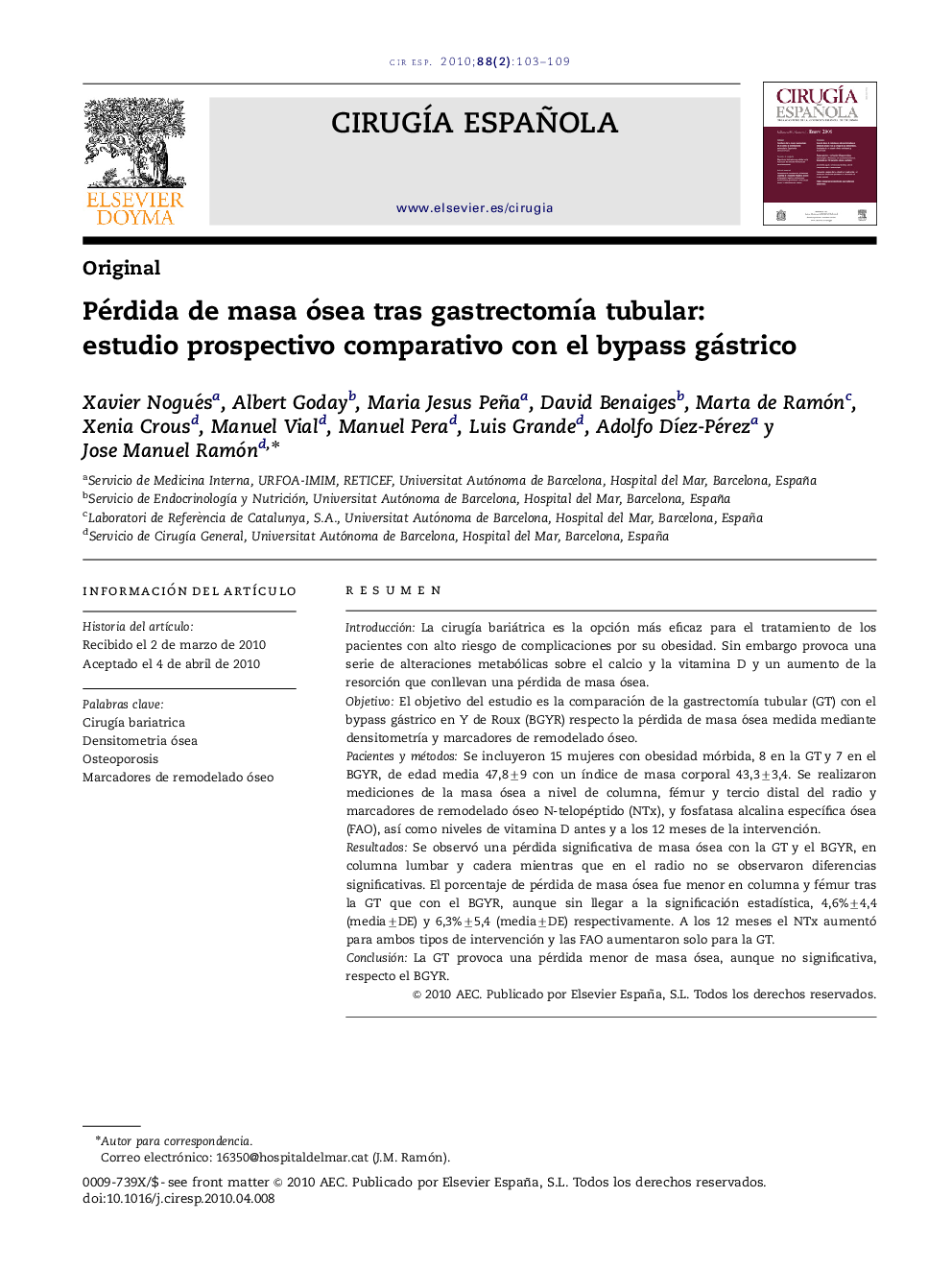| کد مقاله | کد نشریه | سال انتشار | مقاله انگلیسی | نسخه تمام متن |
|---|---|---|---|---|
| 4253026 | 1284256 | 2010 | 7 صفحه PDF | دانلود رایگان |

ResumenIntroducciónLa cirugía bariátrica es la opción más eficaz para el tratamiento de los pacientes con alto riesgo de complicaciones por su obesidad. Sin embargo provoca una serie de alteraciones metabólicas sobre el calcio y la vitamina D y un aumento de la resorción que conllevan una pérdida de masa ósea.ObjetivoEl objetivo del estudio es la comparación de la gastrectomía tubular (GT) con el bypass gástrico en Y de Roux (BGYR) respecto la pérdida de masa ósea medida mediante densitometría y marcadores de remodelado óseo.Pacientes y métodosSe incluyeron 15 mujeres con obesidad mórbida, 8 en la GT y 7 en el BGYR, de edad media 47,8±9 con un índice de masa corporal 43,3±3,4. Se realizaron mediciones de la masa ósea a nivel de columna, fémur y tercio distal del radio y marcadores de remodelado óseo N-telopéptido (NTx), y fosfatasa alcalina específica ósea (FAO), así como niveles de vitamina D antes y a los 12 meses de la intervención.ResultadosSe observó una pérdida significativa de masa ósea con la GT y el BGYR, en columna lumbar y cadera mientras que en el radio no se observaron diferencias significativas. El porcentaje de pérdida de masa ósea fue menor en columna y fémur tras la GT que con el BGYR, aunque sin llegar a la significación estadística, 4,6%±4,4 (media±DE) y 6,3%±5,4 (media±DE) respectivamente. A los 12 meses el NTx aumentó para ambos tipos de intervención y las FAO aumentaron solo para la GT.ConclusiónLa GT provoca una pérdida menor de masa ósea, aunque no significativa, respecto el BGYR.
IntroductionBariatric surgery is the most effective option for the treatment of patients with a high risk of complications due to their obesity. However, it brings about a series of changes in calcium and vitamin D metabolism and an increase in resorption which lead to a loss of bone mass.AimThe objective of this study is to compare sleeve gastrectomy (SG) and Roux-en-Y gastric bypass (RYGB) as regards loss of bone mass using bone densitometry and bone remodelling markers.Patients and methodsFifteen women with morbid obesity were included, 8 by SG and 7 by RYGB, with a mean age of 47.8±9 and mean body mass index 43.3±3.4. Bone mass measurements were made on the lumbar spine, femur and distal radius, and the bone remodelling markers N-telopeptide (NTx) and bone alkaline phosphatase (BALP), as well as vitamin D levels before and 12 months after surgery.ResultsA significant bone mass loss was observed was observed with SG and RYGB, in the lumbar spine and hip, whilst no differences were observed in the radial. The percentage bone mass loss was less in the column and femur after SG than with RYGB, although it did not reach statistical significance, 4.6%±4.4 (mean±SD) and 6.3%±5.4 (mean±SD), respectively. At 12 months the Ntx increased for both types of surgery, and the BAP was only increased for SG.ConclusionSG causes less, although not significant, bone mass loss compared to RYGB.
Journal: Cirugía Española - Volume 88, Issue 2, August 2010, Pages 103–109